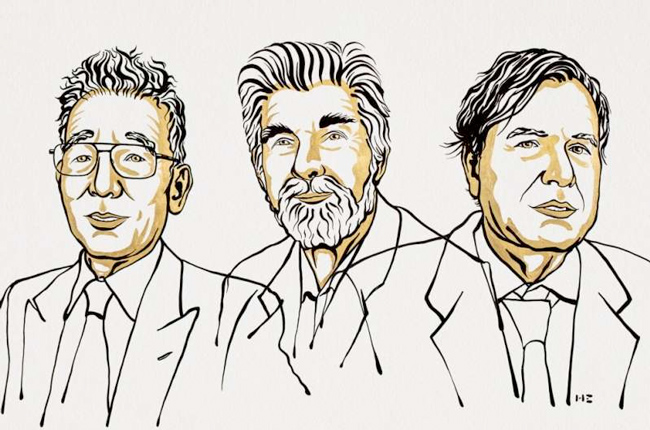Nobel Prize in Physics
Syukuro Manabe, Klaus Hasselmann, Giorgio Parisi
Nobel Prize in Physics Awarded for Study of Humanity’s Role in Changing Climate
The work of Syukuro Manabe, Klaus Hasselmann and Giorgio Parisi “demonstrate that our knowledge about the climate rests on a solid scientific foundation,” the committee said.
The Nobel Prize in Physics was awarded on Tuesday to three scientists whose work “laid the foundation of our knowledge of the Earth’s climate and how humanity influences it.”
The winners were Syukuro Manabe of Princeton University, Klaus Hasselmann of the Max Planck Institute for Meteorology in Hamburg, Germany, and Giorgio Parisi of the Sapienza University of Rome.
The work of all three is essential to understanding how the Earth’s climate is changing and how human behavior is influencing those changes.
“The discoveries being recognized this year demonstrate that our knowledge about the climate rests on a solid scientific foundation, based on a rigorous analysis of observations,” said Thors Hans Hansson, chair of the Nobel Committee for Physics.
Complex systems, such as the climate, are often defined by their disorder. This year’s winners helped bring understanding to the seeming chaos, by describing those systems and predicting their long-term behavior.
Dr. Manabe demonstrated how increased levels of carbon dioxide in the atmosphere lead to increased temperatures on the surface of the Earth.
Nobel physics prize goes to 3 for climate discoveries
The Nobel Prize for physics has been awarded to scientists from Japan, Germany and Italy.
Syukuro Manabe, 90, and Klaus Hasselmann, 89, were cited for their work in “the physical modeling of Earth’s climate, quantifying variability and reliably predicting global warming”.
The second half of the prize was awarded to Giorgio Parisi, 73, for “the discovery of the interplay of disorder and fluctuations in physical systems from atomic to planetary scales.”
The panel said Manabe and Hasselmann “laid the foundation of our knowledge of the Earth’s climate and how humanity influences it.
Starting in the 1960s, Manabe demonstrated how increases in the amount of carbon dioxide in the atmosphere would increase global temperatures, laying the foundations for current climate models.
About a decade later, Hasselmann created a model that linked weather and climate, helping explain why climate models can be reliable despite the seemingly chaotic nature of the weather.
He also developed ways to look for specific signs of human influence on the climate.
Announcement of the 2021 Nobel Prize in Physics
Parisi “built a deep physical and mathematical model” that made it possible to understand complex systems in fields as different as mathematics, biology, neuroscience and machine learning.
After the announcement, Parisi said that “it’s very urgent that we take very strong decisions and move at a very strong pace” in tackling climate change.
“It’s clear for future generations that we have to act now,” he said.
Nobel Committee Press release: The Nobel Prize in Physics 2021
The Royal Swedish Academy of Sciences has decided to award the Nobel Prize in Physics 2021
“for groundbreaking contributions to our understanding of complex physical systems”
with one half jointly to
Syukuro Manabe
Princeton University, USA
Klaus Hasselmann
Max Planck Institute for Meteorology, Hamburg, Germany
“for the physical modelling of Earth’s climate, quantifying variability and reliably predicting global warming”
and the other half to
Giorgio Parisi
Sapienza University of Rome, Italy
“for the discovery of the interplay of disorder and fluctuations in physical systems from atomic to planetary scales”
Physics for climate and other complex phenomena
Three Laureates share this year’s Nobel Prize in Physics for their studies of chaotic and apparently random phenomena. Syukuro Manabe and Klaus Hasselmann laid the foundation of our knowledge of the Earth’s climate and how humanity influences it. Giorgio Parisi is rewarded for his revolutionary contributions to the theory of disordered materials and random processes.
Complex systems are characterised by randomness and disorder and are difficult to understand. This year’s Prize recognises new methods for describing them and predicting their long-term behaviour.
One complex system of vital importance to humankind is Earth’s climate. Syukuro Manabe demonstrated how increased levels of carbon dioxide in the atmosphere lead to increased temperatures at the surface of the Earth. In the 1960s, he led the development of physical models of the Earth’s climate and was the first person to explore the interaction between radiation balance and the vertical transport of air masses. His work laid the foundation for the development of current climate models.
About ten years later, Klaus Hasselmann created a model that links together weather and climate, thus answering the question of why climate models can be reliable despite weather being changeable and chaotic. He also developed methods for identifying specific signals, fingerprints, that both natural phenomena and human activities imprint in he climate. His methods have been used to prove that the increased temperature in the atmosphere is due to human emissions of carbon dioxide.
Around 1980, Giorgio Parisi discovered hidden patterns in disordered complex materials. His discoveries are among the most important contributions to the theory of complex systems. They make it possible to understand and describe many different and apparently entirely random materials and phenomena, not only in physics but also in other, very different areas, such as mathematics, biology, neuroscience and machine learning.
“The discoveries being recognised this year demonstrate that our knowledge about the climate rests on a solid scientific foundation, based on a rigorous analysis of observations. This year’s Laureates have all contributed to us gaining deeper insight into the properties and evolution of complex physical systems,” says Thors Hans Hansson, chair of the Nobel Committee for Physics.
Popular information
They found hidden patterns in the climate and in other complex phenomena
Three Laureates share this year’s Nobel Prize in Physics for their studies of complex phenomena. Syukuro Manabe and Klaus Hasselmann laid the foundation of our knowledge of the Earth’s climate and how humanity influences it. Giorgio Parisi is rewarded for his revolutionary contributions to the theory of disordered and random phenomena.
All complex systems consist of many different inter-acting parts. They have been studied by physicists for a couple of centuries, and can be difficult to describe mathematically – they may have an enormous number of components or be governed by chance. They could also be chaotic, like the weather, where small deviations in initial values result in huge differences at a later stage. This year’s Laureates have all contributed to us gaining greater knowledge of such systems and their long-term development.
The Earth’s climate is one of many examples of complex systems. Manabe and Hasselmann are awarded the Nobel Prize for their pioneering work on developing climate models. Parisi is rewarded for his theoretical solutions to a vast array of problems in the theory of complex systems.
Syukuro Manabe demonstrated how increased concentrations of carbon dioxide in the atmosphere lead to increased temperatures at the surface of the Earth. In the 1960s, he led the development of physical models of the Earth’s climate and was the first person to explore the interaction between radiation balance and the vertical transport of air masses. His work laid the foundation for the development of climate models.
About ten years later, Klaus Hasselmann created a model that links together weather and climate, thus answering the question of why climate models can be reliable despite weather being changeable and chaotic. He also developed methods for identifying specific signals, fingerprints, that both natural phenomena and human activities imprint in the climate. His methods have been used to prove that the increased temperature in the atmosphere is due to human emissions of carbon dioxide.
Around 1980, Giorgio Parisi discovered hidden patterns in disordered complex materials. His discoveries are among the most important contributions to the theory of complex systems. They make it possible to understand and describe many different and apparently entirely random complex materials and phenomena, not only in physics but also in other, very different areas, such as mathematics, biology, neuroscience and machine learning.
The greenhouse effect is vital to life
Two hundred years ago, French physicist Joseph Fourier studied the energy balance between the sun’s radiation towards the ground and the radiation from the ground. He understood the atmosphere’s role in this balance; at the Earth’s surface, the incoming solar radiation is transformed into outgoing radiation – “dark heat” – which is absorbed by the atmosphere, thus heating it. The atmosphere’s protective role is now called the greenhouse effect. This name comes from its similarity to the glass panes of a greenhouse, which allow through the heating rays of the sun, but trap the heat inside. However, the radiative processes in the atmosphere are far more complicated.
The task remains the same as that undertaken by Fourier – to investigate the balance between the shortwave solar radiation coming towards our planet and Earth’s outgoing longwave, infrared radiation. The details were added by many climate scientists over the following two centuries. Contemporary climate models are incredibly powerful tools, not only for understanding the climate, but also for understanding the global heating for which humans are responsible.
These models are based on the laws of physics and have been developed from models that were used to predict the weather. Weather is described by meteorological quantities such as temperature, precipitation, wind or clouds, and is affected by what happens in the oceans and on land. Climate models are based upon the weather’s calculated statistical properties, such as average values, standard deviations, highest and lowest measured values, etcetera. They cannot tell us what the weather will be in Stockholm on 10 December next year, but we can get some idea of what temperature or how much rainfall we can expect on average in Stockholm in December.
also read :
- Super Smash Bros. Ultimate : Halo Developer Says Master Chief Won’t Appear
- What is a 5xx server error instagram? Facebook, Instagram and WhatsApp down ?
- Duffy Shares ‘Passing Thoughts’ With Fans On Instagram Social media
- Lin-Manuel Miranda Directs Andrew Garfield as ‘Rent’ Creator Jonathan Larson
- What Time Will On My Block season 4 release time on Netflix ?
- Titanic : Kate Winslet liked to act in a sex scene with a woman more
Nobel Prize in Physics
The Nobel Prize in Physics is a yearly award given by the Royal Swedish Academy of Sciences for those who have made the most outstanding contributions for mankind in the field of physics.
It is one of the five Nobel Prizes established by the will of Alfred Nobel in 1895 and awarded since 1901; the others being the Nobel Prize in Chemistry, Nobel Prize in Literature, Nobel Peace Prize, and Nobel Prize in Physiology or Medicine.
The first Nobel Prize in Physics was awarded to physicist Wilhelm Röntgen in recognition of the extraordinary services he rendered by the discovery of X-rays.
This award is administered by the Nobel Foundation and is widely regarded as the most prestigious award that a scientist can receive in physics. It is presented in Stockholm at an annual ceremony on 10 December, the anniversary of Nobel’s death. As of 2021 a total of 219 individuals have been awarded the prize.
Andrea M. Ghez
Andrea Mia Ghez is an American astrophysicist and professor in the Department of Physics and Astronomy at the University of California, Los Angeles.
(born June 16, 1965)
Her research focuses on the center of the Milky Way galaxy.[1] In 2020, she became the fourth woman to be awarded the Nobel Prize in Physics, sharing one half of the prize with Reinhard Genzel (the other half being awarded to Roger Penrose).
The Nobel Prize was awarded to Ghez and Genzel for their discovery of a supermassive compact object, now generally recognized to be a black hole, in the Milky Way’s galactic center.
Life beyond the Nobel: Andrea Ghez eyes up new research directions
In the run-up to the announcement of the 2021 Nobel Prize for Physics on 5 October, we’re running a series of blog posts looking at previous recipients and what they did after their Nobel prize-winning work. Last year’s winner Andrea Ghez tells Matin Durrani how the award is already opening up new opportunities for her.
Klaus Hasselmann
Klaus Hasselmann is a leading German oceanographer and climate modeller.
(born 25 October 1931 in Hamburg)
He is probably best known for developing the Hasselmann model of climate variability, where a system with a long memory (the ocean) integrates stochastic forcing, thereby transforming a white-noise signal into a red-noise one, thus explaining (without special assumptions) the ubiquitous red-noise signals seen in the climate.
He was awarded the 2021 Nobel Prize in Physics jointly with Syukuro Manabe for groundbreaking contributions to the “physical modeling of earth’s climate, quantifying variability and reliably predicting global warming” and Giorgio Parisi.
Giorgio Parisi
Giorgio Parisi is an Italian theoretical physicist, whose research has focused on quantum field theory, statistical mechanics and complex systems.
(born 4 August 1948)
His best known contributions are the QCD evolution equations for parton densities, obtained with Guido Altarelli, known as the Altarelli–Parisi or DGLAP equations, the exact solution of the Sherrington–Kirkpatrick model of spin glasses, the Kardar–Parisi–Zhang equation describing dynamic scaling of growing interfaces, and the study of whirling flocks of birds.
He was awarded the 2021 Nobel Prize in Physics for “the discovery of the interplay of disorder and fluctuations in physical systems from atomic to planetary scales,” sharing the prize with Klaus Hasselmann and Syukuro Manabe.
Syukuro Manabe
Syukuro “Suki” Manabe is a Japanese-American meteorologist and climatologist who pioneered the use of computers to simulate global climate change and natural climate variations.
(真鍋 淑郎, Manabe Shukurō, born September 21, 1931 in Ehime)
He was awarded the 2021 Nobel Prize in Physics jointly with Klaus Hasselmann and Giorgio Parisi for groundbreaking contributions to the “physical modeling of earth’s climate, quantifying variability and reliably predicting global warming.”












